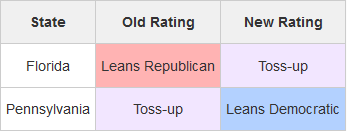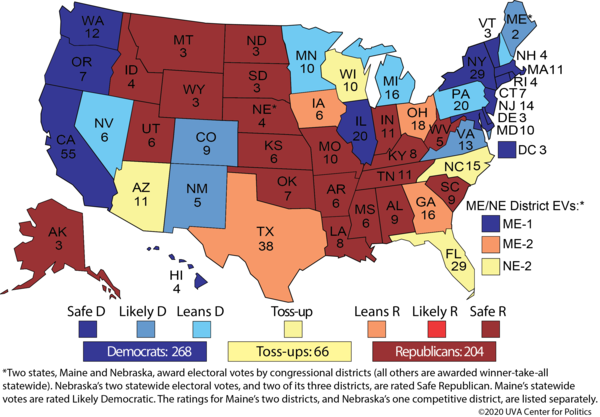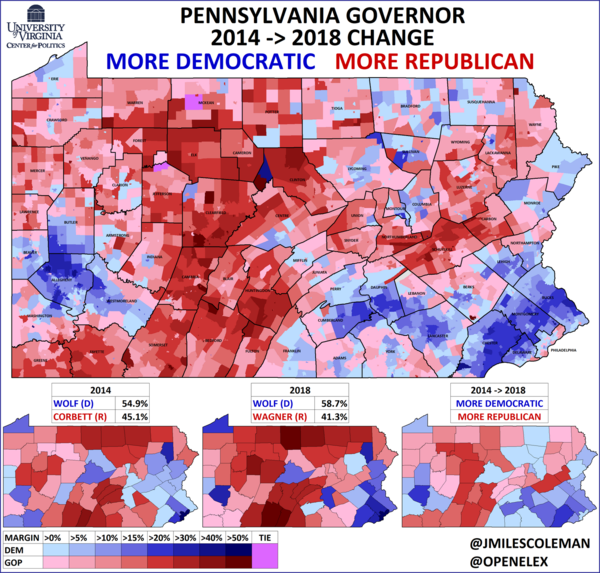The Electoral College: Trump’s Floodgates are Creaking
A Commentary By Kyle Kondik
Florida, Pennsylvania shift toward Biden, but he’s still shy of the magic number 270 in our ratings.
KEY POINTS FROM THIS ARTICLE
— We are making two Electoral College rating changes this week.
— Florida moves from Leans Republican to Toss-up, and Pennsylvania moves from Toss-up to Leans Democratic.
— This means 268 electoral votes are rated as at least leaning to Joe Biden in our ratings; 204 are at least leaning to Donald Trump; and there are 66 electoral votes in the Toss-up category.
— Biden is decently positioned, although his current lead may be inflated.
Table 1: Crystal Ball Electoral College rating changes
Map 1: Crystal Ball Electoral College ratings
The state of the presidential race
When we first debuted our 2020 Electoral College ratings way back in February 2019, we had a couple of ratings that we thought might raise eyebrows: We rated Michigan, Donald Trump’s closest victory in 2016, as Leans Democratic, and Florida, a state he won by just 1.2 points, as Leans Republican.
Our reasoning, in a nutshell, was that we thought Trump’s victory in Michigan was flukier than his wins anywhere else, and a better Democratic campaign effort in Michigan could be enough to flip the state. Meanwhile, we had just seen Democrats lose two statewide races, Senate and governor, in Florida in the midst of a 2018 midterm election where they had dominated many other purple states and districts. Trump had also generally polled a bit better in Florida than he had nationally throughout his presidency to that point.
At the time (Feb. 28, 2019), we wrote the following:
“Those who think we are being unfair to Trump by making Michigan Leans Democratic should consider whether we are perhaps being unfair to the Democratic nominee by making Florida Leans Republican. Ultimately, we’re just trying to reduce the number of Toss-ups where we feel that’s warranted. Just as we think Florida going blue would probably mean a Democratic presidential victory, so too do we believe that a Republican win in Michigan probably would mean that the GOP is retaining control of the White House. So if we move either to Toss-up, it may mean that a favorite is emerging in the presidential race overall.” |
Because we’re moving Florida to Toss-up, and not really considering doing the same to Michigan, it’s fair to say that presumptive Democratic nominee Joe Biden is emerging as a favorite in the presidential race. Not necessarily an overwhelming favorite, but a favorite nonetheless.
Looking at the state of play in the two crucial states of Michigan and Florida help illustrate why.
Biden has led recent Michigan polling — not always by a lot, although sometimes by double digits. Rep. Justin Amash (I, MI-3) decided not to run for president as a Libertarian, preventing him from playing spoiler as an anti-Trump candidate in his competitive home state. And while primary results cannot be used as a proxy for the fall, Biden beat Bernie Sanders in Michigan by a healthy margin in the March 10 primary (when Sanders was still an active candidate), carrying every county after Hillary Clinton had struggled against Sanders in outstate areas four years prior, indicating that, perhaps, Biden was a better candidate for non-metro Michigan — and other similar kinds of places across the competitive industrial north — than Clinton had been.
Meanwhile, in Florida, Biden actually has not trailed a poll since mid-March. Biden has shown some surprising strength with senior citizens in many national polls, leading in some surveys with these voters after the 2016 exit polls showed Trump winning the oldest age cohort by seven. If true, this trend naturally would help Biden disproportionately in Florida, a magnet for retirees. Trump may have also jeopardized a small asset in recent days by suggesting in an interview with Axios that he is open to meeting with dictatorial Venezuelan president Nicolás Maduro and has soured on Juan Guaidó, an opposition leader that the United States has recognized as the true leader of the country. Democrats have sometimes struggled in South Florida with a perception that they are soft on despotic Latin American leaders, like the Castros and Maduro. To the extent that these developments matter to voters in South Florida, Trump may have opened himself up to criticism: There are more than 400,000 Hispanics of Venezuelan origin in South Florida, according to a recent Politico report on Trump’s shifting stances on Venezuela’s leadership (Trump reaffirmed opposition to Maduro in a tweet on Monday).
To be clear, we remain skeptical of the Democrats’ ability to win Florida. Republicans run circles around Democrats in organizing. Even the executive director of the Florida Democratic Party recently told the Washington Post, “In Florida we have a history of fumbling at the two-yard line.” No kidding. To be fair, he then said, “I don’t think we’re going to do that this year,” citing improvements to the Democrats’ organizational efforts and a growing Democratic edge in voters registering to vote by mail. We shall see.
We have one other change this week: We’re moving Pennsylvania from Toss-up to Leans Democratic.
The dynamic in the Keystone State is somewhat similar to that of the Wolverine State: Trump was able to squeak by in each state in large part because of great performances in outstate areas.
Clinton did perfectly well enough in metro Philadelphia and Pittsburgh to win, but she got clobbered so badly outside the big urban areas that she narrowly lost the state to Trump.
The recent changes in Pennsylvania illustrate the larger trends that animate the industrial north — places like Michigan and elsewhere. Trump is hemorrhaging votes among white voters who have a four-year college degree, and who are heavily represented in suburban counties around big cities. That’s why Clinton ran ahead of Obama in much of suburban Philadelphia. However, Trump added votes among white voters who do not hold a four-year degree, who are disproportionately represented in more rural/small city areas. A caveat that we’ll make now that we have made before: possessing or not possessing a four-year degree doesn’t say anything about someone’s intelligence, nor does it necessarily say anything definitive about a person’s income (one can be doing well economically without a degree, or be doing poorly with one). But whether one holds a four-year degree has become a highly salient distinction among white voters.
Based on a 2017 analysis of the 2016 presidential voting by Rob Griffin, John Halpin, and Ruy Teixeira for the liberal Center for American Progress — an analysis we consider superior to the more commonly-cited national exit poll — Trump won white voters without a four-year degree by 31 points, while Clinton won white voters with a four-year degree by seven.
Something that should be concerning to the president is that recent national polling has shown him falling further behind with college whites, not matching his 2016 share with non-college whites, or both.
Quinnipiac University, in a poll released last week showing Biden up eight nationally, had Biden up 22 points with college whites, while Trump was up 26 with non-college whites; Fox News, also released last week, showed Biden up five with college whites, but Trump only up 16 with non-college whites; NPR/PBS NewsHour/Marist College, released a few weeks ago, had Biden up 20 with college whites and Trump up 25 with non-college whites; and New York Times/Siena College, released Wednesday, had Biden up 28 with college whites and Trump up 19 with non-college whites.
Margins of error for these polling subgroups are higher than the polls overall, and there are differences among the findings, but the overall takeaway, to us, is that Trump is losing ground among white voters in aggregate, when he probably needs to be gaining with at least one of the two different groups (non-college versus college).
We can see this dynamic at play in the most recent, high-quality polls of six key swing states, including Pennsylvania, released by the New York Times/Siena College this morning. Biden was up by 10 points in Pennsylvania, and leading in the others (Arizona, Florida, Michigan, North Carolina, and Wisconsin) by margins ranging from six to 11 points. Across the six states, Biden was leading white college voters by 21 while he was down 16 with white non-college voters, significant improvements from what polling showed in these states in fall 2016, the New York Times‘ Nate Cohn reported.
Even in non-presidential races across the country, including Pennsylvania, there have been considerable electoral shifts along educational lines. In his 2018 reelection, Gov. Tom Wolf (D-PA) lost ground in much of Appalachian Pennsylvania, but he more than made it up by improving in the metro areas throughout the state. Despite expanding his margin by seven percentage points from 2014, the only county he picked up was Cumberland. Situated across the Susquehanna River from the capital, Harrisburg, it houses the U.S. Army War College — according to the U. S. Census Bureau’s American Community Survey, an above-average number of Cumberland County’s residents have a bachelor’s degree or higher. By contrast, eight counties, scattered throughout the state, supported Wolf in 2014 but not 2018 — most of these counties, such as Cambria and Carbon, have historically strong ties with the declining coal mining industry and had a once-robust union presence, which buoyed Democratic margins. In all eight counties, a lower-than-average number of residents hold four-year degrees.
Map 2 shows the differences between Wolf’s 10-point victory in 2014 compared to his 17-point win in 2018. Note the dark blue improvement for Wolf in places like Greater Pittsburgh (southwest Pennsylvania), south-central Pennsylvania (Harrisburg/York), and southeast Pennsylvania (Greater Philadelphia).
Map 2: Gov. Tom Wolf (D-PA) results, 2014 vs. 2018
You can see some signals of these Democratic regional trends through other sources. A couple of recent Democratic internal polls of PA-1, a suburban swing House seat covering Bucks County in the Philadelphia suburbs held by Rep. Brian Fitzpatrick (R, PA-1) that Clinton won by two points, have shown Biden up double-digits. Partisan polls, particularly those that are released publicly, usually paint a rosy picture for the side that releases them. However, we’ve seen and heard about enough polling in similar kinds of places across the nation that these surveys may not be that far from the mark. Democrats also appear to have room to grow in the Harrisburg/York area, where another Democratic internal poll of Rep. Scott Perry’s (R, PA-10) district had Biden up one point after Trump won by nine points four years ago. PA-17, a suburban Pittsburgh district won by Rep. Conor Lamb (D) in 2018, is also a prime candidate to switch from Trump to Biden: Trump carried it by just three points in 2016.
At this point, we think there’s enough room for Biden to gain in suburban/exurban Pennsylvania to offset Trump’s big leads in outstate Pennsylvania, and not much reason to think — at this point — that Trump’s level of support outside the big metro areas will be significantly better than 2016. That’s enough for us to push Pennsylvania toward Biden for now.
The big picture
With these changes — Florida to Toss-up, Pennsylvania to Leans Democratic — Biden is at 268 electoral votes at least leaning to him, Trump is at 204, and there are 66 electoral votes worth of Toss-ups: Arizona, Florida, North Carolina, Wisconsin, and the single electoral vote in Nebraska’s Second Congressional District.
At this point, we thought we might remind readers what we’re trying to do with these ratings. They are not designed to reflect current polls, but rather our best guess as to the outcome of the election. The states and districts we call Toss-ups are ones where we don’t feel there is a clear favorite for the fall; the ones we call leans, likely, or safe are those where we feel there is a favorite, to varying degrees.
If we based these ratings just on polls, Trump probably would be in worse shape. Trump’s leads, if they exist at all, are currently tiny in Georgia, Iowa, Ohio, and Texas. Yet we are keeping all in the Leans Republican column, because we have some level of confidence that, ultimately, Trump should be able to win all four states, even if that’s not obvious from polls now. That these states seem so competitive is a telling indicator about the overall state of the race: Biden needs none of them to win, while Trump needs all of them (and then some).
Overall, the president’s problems are many. He planned to run on a strong economy, which now is in ruins, albeit for reasons not of his making. The pain may become more acute without further federal intervention, something the president himself called for earlier this week.
Trump’s responses to two current crises, that of coronavirus and of racial inequalities in policing, have both been unpopular. A few months ago, we wondered if Trump might find himself in the position of Jimmy Carter in 1980: an unpopular president presiding over a bad year in American life. That is certainly one possibility.
But another possibility is that Trump, who has never been popular but has been resilient, is suffering because of the intense focus on him, as opposed to on his opponent, Joe Biden. There are reasons why Trump and his campaign continually ridicule Biden remaining in the shadows: They need to draw Biden out and hope he makes mistakes, so Trump can make himself look better by comparison. The spotlight is clearly off Biden right now, which Democrats have grown not to mind. But the bright lights will move to Biden at some point, and we are curious to see what happens when they do.
Additionally, we have to be on guard for polling, particularly state polling, that may inflate Biden’s lead. Steve Shepard of Politico wrote recently about some of the remaining concerns with state polling. And, going back to Michigan, one of the pollsters that did well there in 2016, Republican pollster Trafalgar Group, recently showed Biden up just one point there. So not all of the numbers have been bad for Trump lately, but most of them have been.
Overall, our suspicion is that Biden’s lead is artificially high right now.
But the problem for Trump is that he was still behind Biden in times that were happier for the president — namely in February, when Biden was lagging Bernie Sanders and coronavirus was something impacting other places, not the United States. But Trump arguably was in striking distance of Biden back then, particularly given Trump’s advantages in the Electoral College, which become more important the closer the race is nationally.
Realistically, we don’t plan to make any major, further changes to our ratings until the big events of August have passed: Biden’s vice presidential pick — as well as Trump’s, in the unlikely event he replaces Mike Pence — and the conventions. We can’t promise we’ll hold to that, but historically the weeks after the conventions present a good opportunity to reevaluate.
Kyle Kondik is a Political Analyst at the Center for Politics at the University of Virginia and the Managing Editor of Sabato's Crystal Ball.
See Other Political Commentary by Kyle Kondik.
See Other Political Commentary.
This article is reprinted from Sabato's Crystal Ball.
Views expressed in this column are those of the author, not those of Rasmussen Reports. Comments about this content should be directed to the author or syndicate.
Rasmussen Reports is a media company specializing in the collection, publication and distribution of public opinion information.
We conduct public opinion polls on a variety of topics to inform our audience on events in the news and other topics of interest. To ensure editorial control and independence, we pay for the polls ourselves and generate revenue through the sale of subscriptions, sponsorships, and advertising. Nightly polling on politics, business and lifestyle topics provides the content to update the Rasmussen Reports web site many times each day. If it's in the news, it's in our polls. Additionally, the data drives a daily update newsletter and various media outlets across the country.
Some information, including the Rasmussen Reports daily Presidential Tracking Poll and commentaries are available for free to the general public. Subscriptions are available for $4.95 a month or 34.95 a year that provide subscribers with exclusive access to more than 20 stories per week on upcoming elections, consumer confidence, and issues that affect us all. For those who are really into the numbers, Platinum Members can review demographic crosstabs and a full history of our data.
To learn more about our methodology, click here.



